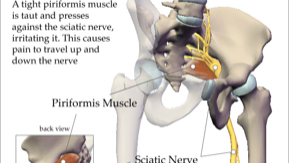
By Alison Ford
If you are experiencing hip, buttock, hamstring or sciatic pain then you may be suffering from Piriformis Syndrome.
Piriformis syndrome is a disorder which occurs when your sciatic nerve is compressed or irritated by the piriformis muscle as it passes through your buttock, resulting in pain, often radiating up or down the sciatic nerve.
Where is your Piriformis Muscle?
Your piriformis muscle originates mostly from the base of your spine and inserts onto the top of your thigh bone. It rotates your hip outwards.Your piriformis and your sciatic nerve both pass through a small opening in the pelvic bone called the sciatic notch. In some of us the sciatic nerve actually passes through the piriformis itself. This close proximity can be problematic.
What are the Symptoms of Piriformis Syndrome?
- Pain is usually felt in one buttock and you may experience radiation of pain down the back of your leg (sciatica).
- You may sit or stand lopsided tilting away from the painful side.
What Causes Piriformis Syndrome?
Your piriformis muscle will be overworking and therefore becomes strained. It might be because it is protecting adjacent joints or due to a weakness in your hip or back muscles. It is often associated with low back stiffness. The way you walk or the position of your foot on the ground might be causing your leg to rotate and thereby straining your hip rotator.
What’s the Treatment for Piriformis Syndrome?
After a thorough clinical assessment your physiotherapist will determine the cause of your pain. Once your diagnosis is established, treatment will be along the lines of spinal adjustment and mobilisations, muscle releases, laser therapy and stretching and strengthening exercises to maintain the changes.
An early diagnosis by your Physiotherapist is optimal. Your pain should be relieved after several days as the cause is investigated and treated.





